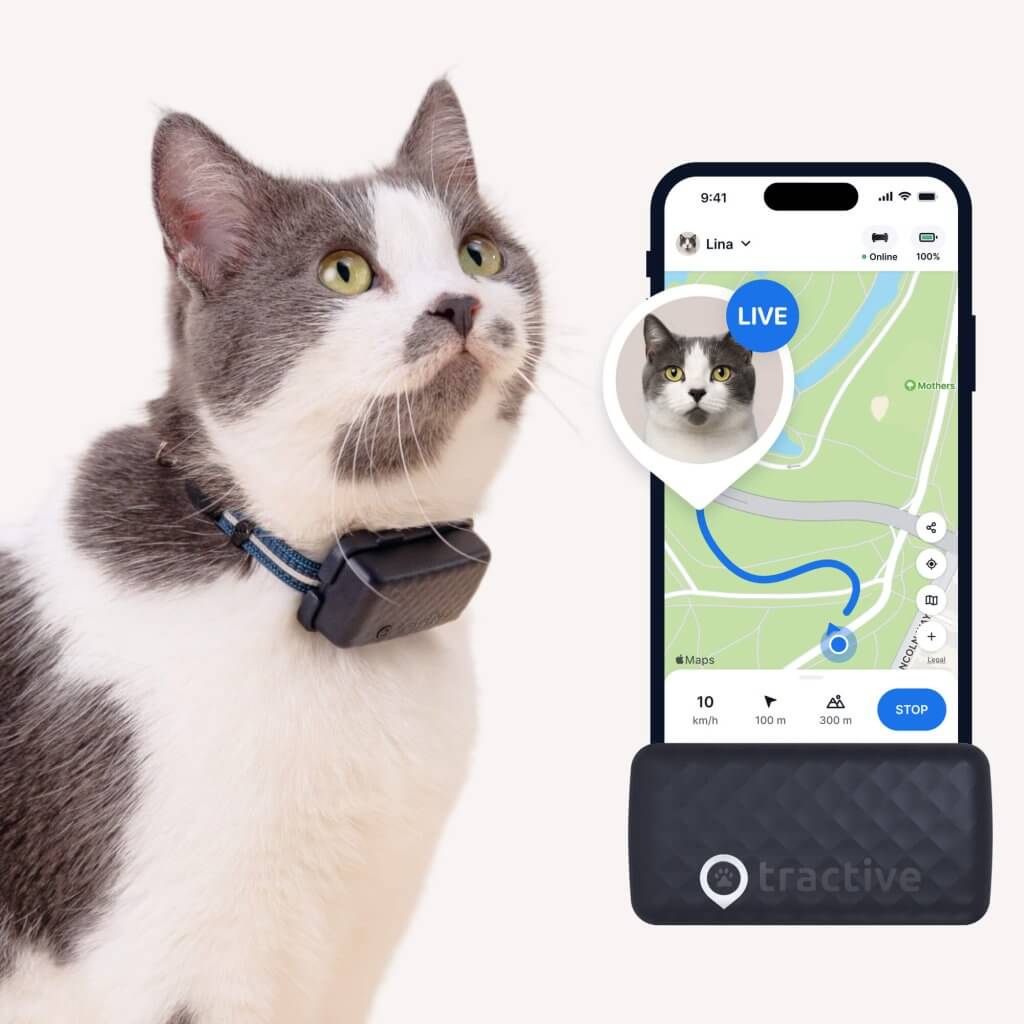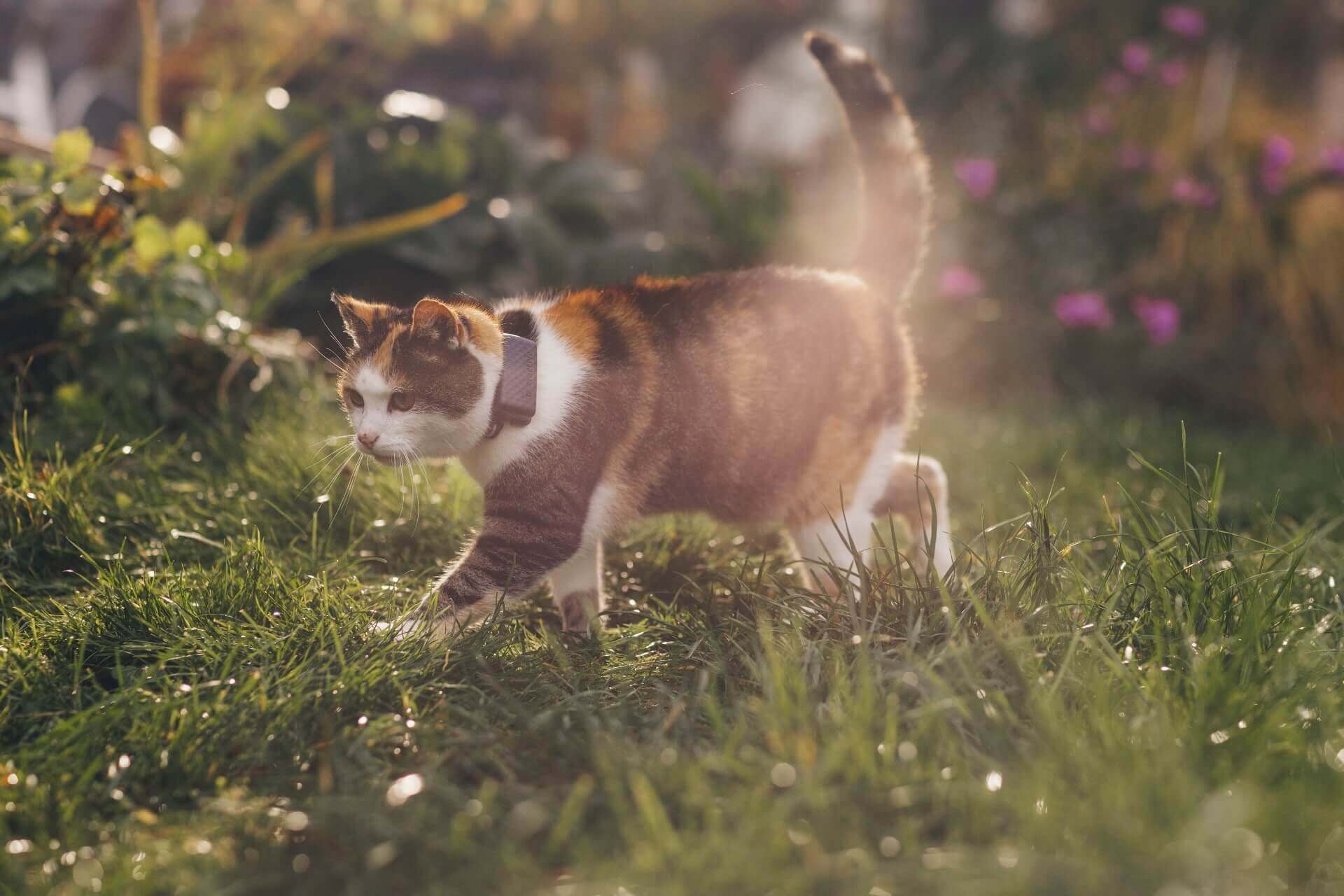How Hot Is Too Hot for Cats? Our Tips To Beat The Heat
They might be napping in warm spots all day - but how hot is too hot for cats, both indoors and outdoors? Let's find out.
While cats are known for their love of sunbathing, they’re still at risk for potentially fatal conditions like heat stroke. But how hot is too hot for cats – both indoors and outdoors? Let’s dive into what you need to know to keep them safe and how a smart cat collar with real-time GPS and Health Monitoring can help prevent an emergency.
Key Takeaways
Indoor temperatures consistently above 30°C (86°F) are risky; above 35°C (95°F) can be an emergency without proper cooling or water. Ensure good air circulation and plenty of water.
Keep cats indoors if temperatures exceed 29°C (85°F), especially during peak heat. Never leave a cat in a parked car.
Head to your vet if you notice any signs of overheating like excessive panting, drooling, lethargy, or stumbling.
A Tractive GPS & Health Monitoring collar can help prevent emergencies by providing real-time location tracking and activity monitoring. So you can find your cat in no time – and bring them home before it gets hot outdoors.

Find out where your cat spends their time.
Read moreWhat’s the ideal temperature for cats?
Cats’ ideal comfort zone typically falls between 20-26°C (68-79°F) – but this can depend on your cat. Some cats can tolerate temperatures up to 35°C (95°F) indoors! You might even have noticed yours heading for a nap to a room without air conditioning. (Even on a hot day.)
However, how hot is too hot cats can depend on factors like their breed, age, fur length, and overall health. For instance, long-haired breeds, older cats, kittens, and those with underlying health conditions (like heart disease or obesity) are more vulnerable to heat stress.
Cats also tend to have a higher body temperature than humans. This averages to 37-38°C (100°F-102°F). But unlike humans, cats don’t sweat through their skin like we do. Instead, they primarily cool down through:
- Their paw pads (which have sweat glands)
- Panting (though less common than in dogs and often a sign of distress),
- and by seeking out cooler surfaces or shade
⚠️ Generally, if a cat’s body temperature goes above 39°C (103°F), it’s a sign they’re overheating and require immediate attention. What feels warm to us might be comfortable for them. But there’s a fine line before it becomes dangerous. Always observe their behavior and look for the signs of overheating.
How hot is too hot for cats outdoors?
If the outdoor temperature is above 29°C (85°F), it’s generally best to keep your cat indoors. This applies especially during the hottest parts of the day (usually between 10 AM and 4 PM), when the sun is most intense and surfaces can become dangerously hot. Humidity also plays a significant role, with high humidity making it much harder for cats to cool themselves through evaporation, increasing their risk of heatstroke.
Specific outdoor risks include:
- Hot surfaces
Pavement, asphalt, and even dark-colored patios can absorb and retain heat. Within minutes, they can reach scorching temperatures that can quickly burn your cat’s sensitive paw pads. - Limited shade and water
Unlike indoors, cats outside may struggle to find adequate shade or a consistent supply of fresh, cool water, leading to dehydration and overheating. - Enclosed spaces
Cats can sometimes get trapped in sheds, garages, or other outdoor structures that can quickly become ovens in hot weather, leading to rapid heat buildup.
That’s why the safest option during heatwaves is to keep your cat strictly indoors.
If they must go out, make sure they have constant access to shade, fresh water, and monitor them closely. You can also set up multiple water stations in shaded areas. Consider a pet-safe paddling pool with a small amount of water if your cat enjoys it.
Finally, never leave a cat in a parked car. Even with the windows open, temperatures inside a vehicle can skyrocket to dangerous levels in a matter of minutes, leading to fatal heatstroke.
💡A smart cat collar with real-time GPS tracking can be an extra pair of eyes on your outdoor cat. With just a glance at your phone, you can switch to LIVE tracking and see where they’re off wandering, down to the smallest step. So you know just where to find them and bring them home before it gets too hot outdoors.

Track your cat wherever they go
Get real-time location information, wherever they go. Find out when they go somewhere they shouldn’t, with Virtual Fences. And discover their favorite spots with Territory.
How hot is too hot for cats indoors?
Generally, if your indoor temperature consistently exceeds 30°C (86°F), it’s starting to get risky for many cats, particularly if there’s no air circulation. This temperature can lead to discomfort and mild heat stress. Any temperature above 35°C (95°F) without proper cooling or access to water can quickly become an emergency, potentially leading to heatstroke. Older cats, kittens, overweight cats, and those with respiratory or cardiovascular conditions are more susceptible to indoor heat.
Watch out for rooms with:
- A lack of air circulation
Stagnant, hot air can quickly raise a cat’s body temperature. - Direct sunlight
Rooms with large windows can become sun traps, significantly increasing the ambient temperature. - High indoor humidity
Which makes it harder for cats to cool themselves through evaporation.
That’s why we’d recommend you keep your curtains closed on sunny windows to block direct sunlight. Use fans – but don’t point them directly at your cat for long periods (as this can dry out their eyes and skin). Ensure your cat can always drink plenty of fresh, cool water in multiple locations, and consider frozen treats or cooling mats. You can also leave bathroom doors open for access to cool tile floors, or even place ice packs wrapped in towels in their favorite resting spots.
Read more: How To Keep Cats Cool In Summer: Your Ultimate Guide
How to spot the signs of overheating in cats
Early signs:
- Restlessness or agitation
Especially if your cat is trying to find a cooler spot. - Excessive grooming
Your cat might lick their fur in an attempt to cool down. - Sweaty paws
Watch out for damp paw prints. - Increased panting or rapid breathing
Unlike dogs, cats rarely pant unless they are stressed, in pain, or overheating. This is a serious sign. - Drooling
- Vomiting
Advanced signs that count as an emergency:
- Lethargy or weakness
Your cat might seem unusually tired or unresponsive. - Stumbling or disorientation
Watch out if your cat seems to experience difficulty walking straight. - Bright red tongue and gums
This is a sign of increased blood flow to cool down. - Muscle tremors or seizures
- Collapse or loss of consciousness.
⚠️ If you notice any of the advanced signs of overheating, or if the early signs persist and worsen despite your efforts to cool your cat down, it’s an emergency. Get to the vet immediately. Heat stroke in cats can cause irreversible organ damage and even be fatal if not treated promptly.
How to cool down your cat
If you suspect your cat is overheating, here are some immediate steps you can take while you’re on your way to the vet:
- Move them somewhere cooler
The very first step is to get your cat out of the heat source. Move them indoors to an air-conditioned room, a shaded area, or even a bathroom with a tile floor. - Offer small amounts of cool (not ice-cold) water
Don’t force them to drink, especially if they are disoriented or unconscious, as this could lead to choking. You can also offer ice cubes in their water bowl or a bowl of cool broth. - Gently wet their fur with cool (not ice-cold) water
Focus on areas where blood vessels are close to the surface, like their paws, ears, and belly. You can use a damp cloth, a sponge, or even a spray bottle with a fine mist. Do not use ice water, as this can cause their blood vessels to constrict, trapping heat inside their body and actually hindering cooling. - Position a fan to blow air gently over your cat
This helps to evaporate the water from their fur, which in turn helps to cool them down. - Avoid over-cooling
While it’s important to cool them down, be careful not to overdo it. Once their temperature starts to drop, or they show signs of improvement, you can reduce the cooling efforts. - Monitor your cat closely
Keep a close eye on their breathing, responsiveness, and gum color. Continue to monitor them even after they seem to be recovering, as heats troke can have delayed effects.
Remember, these are first aid measures. If you suspect your cat is overheating, it’s important to get them to your vet for a checkup right away.
Where a smart cat collar can help prevent an emergency
Imagine this scenario: your outdoor cat is out exploring, or your indoor cat sneaks out when the sun’s at it’s zenith. Strapped to your cat’s collar, your trusty Tractive device can be an invaluable tool in preventing heat-related emergencies.

Because now, with just a glance at your phone, you can:
- Instantly see your cat’s location in real-time
With LIVE tracking from your Tractive mobile app. If they’ve wandered into a sunny, exposed area with no shade or get trapped somewhere hot, you can quickly retrieve them before they get into trouble. (Plus, unlike an AirTag, your Tractive device doesn’t need a network of compatible devices to work.) - Get alerted if your cat escapes home or the yard
Which you can mark as “safe zones” via the app. (Or “no go zones” for areas you’d rather they steer clear from.) Now if your cat sneaks past a safe zone or enters a no go zone, you’ll get an escape alert to your phone. So you can intercept them before they wander off.


- Figure out where your cat spends most of their time
From their Heat Map and Location History. Which helps you understand what spots around your home, backyard, or neighborhood your cat likes to hide, hunt, or patrol around. Your tracker also marks out your cat’s territory, so you’ll know where to look first in an emergency. (Like if they’re missing.) - Spot the signs of heat stress early
With its built-in motion detector, your tracker can help you catch on earlier to a sudden drop in your cat’s activity, or unusual restlessness. All of these could be an early indicator of discomfort or heat stress. In these cases, you’ll get a Health Alert prompting you to check on them.
Now that we’ve covered how hot is too hot for cats, you’re better prepared for keeping them safe during hot weather. By understanding their temperature preferences, recognizing the symptoms of overheating, and figuring out a way to monitor their whereabouts – you can keep them cool, healthy, happy, and safe all summer long.
And if you’ve liked this post, share it with a friend or a loved one – and let’s help build a safer, kinder world for our furry friends together. Happy summer!



